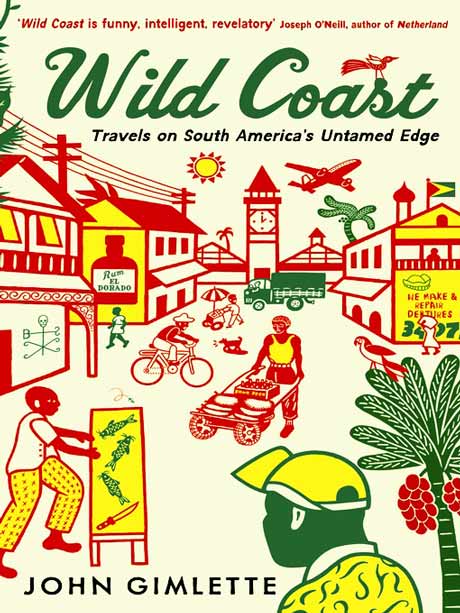Book Review
Gimlette's 'Wild Coast'

A review by Frank Birbalsingh
Wild Coast: Travels on South America's Untamed Edge is an account by English author John Gimlette of his travels through Guyana, Surinam and Guyane whose Northern borders form part of the continuous "untamed" Atlantic coastline stretching from the Orinoco River of Venezuela in the West to the Amazon River of Brazil in the East. "The Wild Coast" was the name first given by European explorers to these three territories which were former colonies of Britain, Holland and France. Gimlette, a seasoned traveller, already had three books under his belt dealing with his travels through Europe, Canada and Peru respectively, before he began his journey in English-speaking Guyana in 2008; and although he moves steadily Westward through Dutch-speaking Surinam, then French-speaking Guyane, he devotes more than half of Wild Coast to the Guyana leg of his journey.
His opening salvo describing Guyana's population as: "a hotchpotch of displaced souls: slaves, Amerindians, Dutch conquerors, 'Chineymen' [Chinese], Irish adventurers, Scottish cattlemen, pirates, pioneers and pathans" sounds playful, almost irresponsible, and betrays an overpowering eagerness to entertain. We see this again in Gimlette's title for the chapter on Guyana's capital city: "Town of George"; or the chapter on the Jonestown massacre: "Town of Jones." Not that any of this is inaccurate or misleading, it is just that the author plumps for phrasing that is lively, exhibitionist or eye-catching.
For all that, Gimlette touches on essential aspects of Guyanese life, for instance, the centrality of its two main ethnic groups – Indians and Africans; and he quickly spots contradictions when speaking to his driver Ramdat who claims to be not only Indian but Bengali although: "He no longer spoke the language or wore the clothes, and he wasn't even sure where Bengal was." Relying on interviews with Guyanese informants Gimlette also comments on political disturbances, riots and ethnic killings in the early 1960s, and discloses President Forbes Burnham's reason for rigging elections: it was the only way his minority ethnic group could rule, and it was why Burnham became "an assiduous enforcer" who: "invented an entire electorate of ghosts and Mickey Mouses, and Guyanese with addresses in the fields."
Although it made international headlines more than thirty years ago, the story of Jonestown still remains harrowing today: a "religious" commune consisting of over nine hundred ageing, mostly black Americans, led by a mysterious preacher Jim Jones, and living in the heart of dense tropical forest in North West Guyana since 1977, only to be followed one year later by 909 members committing mass suicide by drinking poison on the instructions of their leader. Also killed by shooting are Leo Ryan, a visiting US Congressman, and three American newsmen. Gimlette's account is brisk and diverting, relying on reports by visitors like himself and local people who witnessed the tragedy or its scene soon afterwards. He captures both the horror and mystery of Jonestown: "Was this really an agricultural Utopia, or just a cranky sanctuary for the lost and dispossessed?"
Gimlette's next chapter "The Golden Rupunini" lavishes attention on savannah life in the Rupunini district, and on the archetypal Guyanese legend of Eldorado: "the great king who lives on a lake and has subjects cover him with powdered gold." The legend ensnared the likes of Sir Walter Raleigh who failed to find Manoa, the city of gold, and was executed in 1618. Gimlette also relishes local Amerindian lore about a long-haired monster variously called the Water tiger or Dai Dai , Massa Couraman, Ouata-mama or the Water monkey. Most of all though it is the sights and sounds of the forest that prove irresistible with "a flurry of nightjars," "a gentle lullaby of croaks," and "a ludicrous bug like a lawnmower," then "all of a sudden the evening was torn apart by the sound of a sawmill bursting into life. It was all the work of a single beetle." But probably the best chapter in the book describes the failed 1763 rebellion of African slaves against their Dutch owners in Berbice, today a county in Guyana. As Gimlette observes: "Berbice was on the brink of becoming South America's first and only republic of slaves."
In Surinam Gimlette is struck by the beauty of Paramaribo the capital city. He notes the presence of maroons, escaped African slaves consisting of Saramaccaners and other tribes who still preserve African customs, and makes much of John Stedman's classic memoir Expedition to Surinam, Being the Narrative of a Five years Expedition against the Revolted Negroes of Surinam, in Guiana, on the Wild Coast of South America, from 1772 to 1777, and of Stedman's story of Joanna, a female slave whose story was extracted from Stedman's account and republished independently as her own story Narrative of Joanna an Emancipated Slave of Surinam.
Taking his final Westward step Gimlette moves to Guyane which is popularly equated with an island off its Northern coast known as Devil's island, notorious as settlement for hardened criminals. He tells the story of an extraordinary journey through Guyane by Frenchman Raymond Maufrais who eventually published Aventures en Guyane portraying the country as: "a white man's grave, a green hell." Gimlette also visits various barracks and discusses celebrated convicts such as Alfred Dreyfus and Francis Lagrange a forger. His mention of a new group of settlers, known as the Hmong, who came to Guyane from Mongolia, Tibet, Lapland or somewhere in 1977, also drives home the point about Guyane serving as an historic repository of the unwanted. As he is about to leave the author reflects on his trip as a whole: "Along this coast mankind has always been made to feel a little frail. It's not just the flora and fauna, but the sheer scale of the forest beyond. Ghosts and magic have always thrived ... in a land comprising three different countries, three different cultures, three official languages, three currencies, myriad religions and umpteen different races."